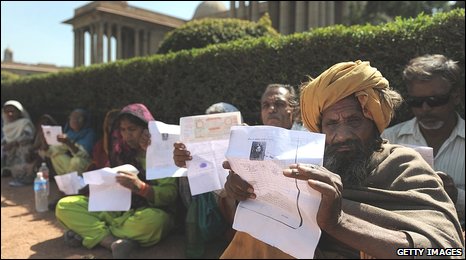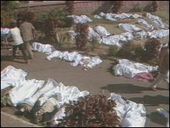
© Getty ImagesOngoing: Survivors campaign outside PM Manmohan Singh's office this month
A quarter of a century has passed since Bhopal suffered the world's worst industrial disaster, but its legacy lingers.
There is an air of palpable sadness hanging over the city - and everybody has a story to tell about that night.
And the Indian government has at last decided to fund new research into the long-term health effects of the toxic leak.
"It looked like hail on the ground - like snow - there were so many shrouds. Everywhere you looked in the city, there were shrouds," Yassir Nadir recalls with a shudder.
"The hospitals and mortuaries were overflowing. People just dropped dead in the street while they were walking.
"I saw with my own eyes a dead man being taken on a stretcher to the morgue, when suddenly he sat up. Who knows how many other living people did not wake in time."
'Chaos on the streets'
At five-past midnight on 3 December 1984, a gas tank exploded at the US-owned Union Carbide pesticides manufacturing plant, releasing 40 tonnes of methyl isocyanate (MIC gas) in a lethal cloud that dispersed over the densely populated city of nearly a million people.

© BBC NewsDead bodies covered by shrouds
At least 2,000 people died that night, according to government figures - aid organisations estimate 5,000 died in the first 72 hours, and a further 15,000 in the following weeks.
Of the living, at least 100,000 are chronically ill from their exposure to the toxic gas, and a further 30,000 are still drinking and washing in contaminated groundwater.
Nadir was lucky. He was visiting friends a few kilometres from the old city.
"My eyes began to sting, and I thought someone must be cooking nearby with chillies. We were watching The Godfather film and it started to look a little blurry, but I didn't think anything of it," he says.
"The next day I went to the school where I worked as an administrator, and found it shut and chaos on the streets.
"People were running from the city leaving everything behind - all of their belongings, even their children. But nobody knew anything about what had happened."
In fact, it wasn't until three days after the incident that most people, including Nadir, learned what had occurred via radio and newspaper reports.
MIC is a highly reactive gas that attacks the eyes and lungs, blinding and suffocating its victims.
"It attacks the alveoli and crosses the pulmonary barrier into the bloodstream, from where it affects every other organ," says Roopa Baddi, a GP who treats patients in the shanty area surrounding the now-defunct plant.
She reels off a list of conditions that she sees resulting from the gas, including incidences that are far higher than the national average of lung diseases such as fibrosis and tuberculosis; cancers, especially of the bladder, cervix, lungs and oesophagus; eye disorders, such as early-onset cataracts and blurred vision; infertility and menstrual problems; kidney (renal) failure; joint problems; mental health issues and damage to the immune system.
Women who were pregnant at the time of the explosion suffered a high proportion of spontaneous abortions and stillbirths. And many children born after in-utero exposure - or conceived after the incident but whose parents were exposed - have health problems and retarded growth and development, a team of researchers reported in 2003 in the Journal of the American Medical Association (Jama).
Prior to the 1984 leak, pesticide wastes were dumped to the north and east of Bhopal city.
The chemical waste was disposed of in landfill sites and three purpose-built ponds.
Campaigners say chemicals from these ponds are now contaminating the groundwater.
Locals claim a range of disorders: skin, eye, joint and intestinal problems; rising cancer rates.
Sambhavna Trust Clinic has campaigned for clean water to be piped in for drinking and bathing.
It also wants the current site owner, Dow Chemical, to clean up and seal the ponds
Dow Chemical, which bought Union Carbide, says it is not responsible for the mess.
Indian government says it does not have the resources to decontaminate the area.
Protests in 2007 led to the government funding a limited supply of piped water.
The Bhopal explosion remains the subject of ongoing court cases in India and the US.
A lack of dataThe Sambhavna Clinic, with its calm, clean design and beautifully tended garden of medicinal herbs, rises brilliantly out of the sprawl of slum dwellings, open sewers and litter-strewn alleys that surround the closed pesticides plant.
The charitable centre, with its eco design features including rainwater harvesting, solar panels and waste water recycling, feels like a physical embodiment of the area's hopes. And judging by the queues of patiently waiting locals, quite a few are pinning theirs on it.
The clinic, which treats only victims of the pesticide plant, using conventional and herbal medicines in combination with techniques such as yoga, was borne out of frustration at the lack of care being provided for the victims by the government.
It is funded through donations from individuals, mainly by British people responding to newspaper ads, and the royalties from a book on the subject by the French writers Dominique LaPierre and Javier Moro.
Inside, "Sathyu" (Satinath) Sarangi, a tall man, wearing Western clothes topped off with a traditional turban, greets me with a gentle smile.
Sathyu helped set up the clinic and research centre in 2001 and was one of the authors of the 2003 Jama study. He says that one of the main difficulties doctors face is a lack of biological data on the effects of the gas.
"Union Carbide, and its current owner Dow Chemical Company, are continuing to withhold the results of studies into the effects of MIC on living tissue that were done at Carnegie-Mellon Institute in the late-70s and early 80s," he says.
"There is no treatment protocol for the complex conditions that people exhibit and so the doctors treat the symptoms with large quantities of painkillers, antibiotics or steroids, all of which compound the problem with their side effects."
Union Carbide maintains that is has shared all toxicity information with the Indian government.
Memorial plantThere has never been an official investigation into the long-term health effects of the leak. The Indian government stopped its research into the medical effects of the gas without explanation 15 years ago.
Now, the Indian Council of Medical Research has announced that it will fund scientists investigating the long-term health effects of the disaster and to "see whether the toxic waste posed a threat to people even now".
It's a small victory for Sathyu and his colleagues, who have spent the past two-and-a-half decades campaigning for adequate medical treatment and financial compensation for the victims, and for those responsible to be punished - so far, the US and Indian officials convicted have escaped sentences.
This is a tragedy that could so easily have been avoided. If cost-cutting officials at the plant had not shutdown the tank's regulatory pressurisation and refrigeration systems; if the valves had been maintained properly and not allowed to leak water into the gas tank, sparking a catastrophic runaway reaction; if the vapour absorption ("scrubbing") system had been in use, it might never have happened.
Perhaps the sorriest fact is that the MIC need not have been there at all. It was an intermediate, not a product or raw material.
After the disaster, Du Pont announced that it would use MIC in its plants as soon as it is produced, so that instead of 40 tonnes in a tank there would be only 5-10 kg in a pipeline.
Groups representing the survivors and victims of the tragedy appealed to Unesco earlier this month for the Union Carbide plant to be preserved as an Industrial Heritage Site of international importance, so that the building would stand as a memorial to the disaster and educate future generations.
Survivors say that they will "physically block" any attempts to dismantle the remaining structure. Other Unesco Industrial Heritage Sites include the Nazi concentration camp at Auschwitz.
The ICMR initiative is directed at outside research groups because it does not have the staffing itself to undertake the research.
Study areas will include investigations looking at whether the toxic gases caused genetic disorders, low-birth weight, growth and development disorders, congenital malformation, retardation of genitalia; and reproductive functions will also be assessed.
The issue of whether chromosomal abnormalities have resulted from exposure will be substantiated by a trans-generational study among those who were exposed, and unaffected people of Bhopal.
The research will also examine whether the toxic waste poses a threat to people even now.
Reader Comments
to our Newsletter